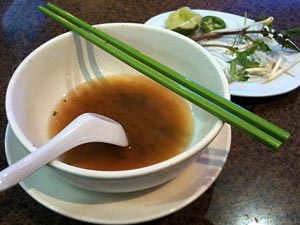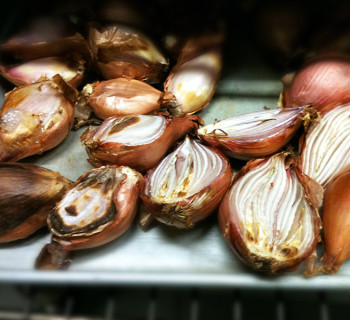 The question is: Are there secrets to making the perfect pho at home? Well, people in Vietnam do not actually make pho at home. Even if they know how, they do not really bother to cook it themselves because it is far easier and cheaper to walk a few steps to a street stall that sells good pho. Home-made pho is the unique product of Viet immigrants arriving at foreign shores after 1975.
The question is: Are there secrets to making the perfect pho at home? Well, people in Vietnam do not actually make pho at home. Even if they know how, they do not really bother to cook it themselves because it is far easier and cheaper to walk a few steps to a street stall that sells good pho. Home-made pho is the unique product of Viet immigrants arriving at foreign shores after 1975.
By contrast, Viet immigrants to other countries can and do try their hands at cooking pho at home, initially out of necessity. Learning how to cook pho, for these Viet immigrants, is a way for them to keep the link with the homeland alive, to heal wounds caused by displacement, and to remind themselves of their own heritage. Nowadays, however, it's more about convenience and good times to meet friends at a pho shop.
Because pho is essentially a dish that knows no language or boundaries, many non-Vietnamese have fallen in love with pho and have developed the desire to learn how to cook pho in their own kitchens. The thing is, it is far too easy to make a bad bowl of pho than it is to make a good one. To make good pho at home, one has to pay attention to the details of cooking it. And thanks to the Internet, good pho recipes can be found much more easily than at any time before. See my articles on Ten Pho Recipes from Around the Web and Pho Broth.
Looking for a solid beef pho recipe? Check out Lovingpho’s own Beef Pho Recipe infographic.
So let's get back to the question of secret techniques to creating the perfect pho. One of the great qualities of pho is that techniques vary – no two bowls of pho made from two separate kitchens will ever taste the same. A chef's creativity is always a good thing, but it's important to understand that, while the previous statement is true, there is a narrow range of acceptability outside of which your home-made pho dish is actually becoming something else.
Many Vietnamese outside of Vietnam will tell you that the perfect pho is the one made by his/her own mother. That may be true probably because they grew up with it. But, for me, the perfect bowl of pho is the one that you keep coming back for more, whether it's made at home or in a restaurant. Regardless, here are some basic techniques that can help in your quest to make good pho yourself.
- Choose good beef bones. Your choice of beef bones for making your pho broth is very important. The bones and the marrow in them will give the foundations of the flavor of your broth. For great-tasting broth, choose knuckle bones, leg bones and oxtail.
- Keep your broth clear. There is a reason why you need to pay attention with the simmering of your broth, even if the length of time it takes can test your patience. You need to 1) maintain a light simmer, and 2) continually skim the scum and foam off the top of the broth. A clear broth is one of the essential qualities of pho. It means that the broth has been rid of all the impurities from the bone and protein. One tip for achieving clarity in your broth is to boil the bones and meats for 3 to 5 minutes (parboiling,) then rinse them before starting the simmering process using fresh water.
- Balancing the taste. When making pho, always aim for a good intense flavor in the broth. You may need to add some water during the simmer or at the end, because prolonged simmering will reduce the liquid volume. Just make sure to not over top it off, or you will dilute it. A good method to employ is add just enough water to reach a point a tad above the saltiness level of your palate. This way, your pho will come out tasting great when the broth is served over rice noodle and other ingredients in the bowl.
These are just some of the techniques that most veteran home cooks follow when making Vietnamese pho. It's not a surprise that they all pertain to the creation of good broth. That is because coming up with a good broth for pho is the first, and toughest, step toward making the perfect pho. Once you have a great broth, the rest should just fall into place.
And the best sign of a perfect pho is an empty bowl with the chopsticks resting across it.



